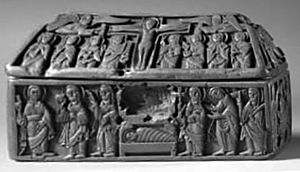Uttoxeter Casket facts for kids
The Uttoxeter Casket, also called Philip Nelson's casket, is a special Anglo Saxon box. It is a reliquary, which means it was made to hold important religious items, like a saint's bone or a piece of something holy. This casket comes from Uttoxeter, a town in Staffordshire, United Kingdom. Since 2017, you can see it at the Cleveland Museum of Art in Ohio, United States.
This unique box is shaped like a small house. It was carved from a single piece of boxwood, which is a type of wood. It is the only known wooden carving from this time in British history that has so many detailed pictures on it.
Contents
The Casket's Story
The top part, or lid, of the Uttoxeter Casket was found in the mid-1800s. It was discovered near a small house in Uttoxeter, Staffordshire. A local historian, Francis Redfern, wrote about it in the 1850s. He mentioned a "curious carved oak panel" found near Croxden. This panel showed Jesus and his twelve followers.
It is thought that the box might have come from Croxden Abbey. This was a large religious building nearby. The box might have been taken or hidden when monasteries were closed down in 1538. This event is known as the dissolution of the monasteries.
Finding the Pieces
In 1936, the lid of the box was taken to the Victoria & Albert Museum (V&A) in London. At that time, it was owned by a convent. Meanwhile, a collector from Liverpool named Philip Nelson had bought the bottom part of the box in 1921. He paid £175 for it. Nelson loved collecting old and rare items.
He soon learned about the lid at the V&A. He realized that the two wooden pieces belonged together! Nelson convinced the convent to sell him the lid for £120. This was a big moment, as the box and its lid were finally put back together. They had been separated for at least 100 years, or maybe even longer.
The Casket's Journey
After reuniting the pieces, Philip Nelson lent the casket to the V&A. It was on display there from 1937 until he passed away in 1953. Nelson also wrote an article about the casket in a well-known old-history magazine called Archaeologia.
After Nelson's death, the casket was sold to a dealer in America. Later, it was bought by The Cleveland Museum of Art. This is where it is kept today.
What Does It Look Like?
The Uttoxeter Casket is a very rare and special example of Anglo-Saxon wood carving. It was made around the year 1050. The box is decorated with many scenes from the life of Jesus.
Carvings and Scenes
On one long side, you can see baby Jesus resting in a manger. Above that, there is a picture of the Crucifixion. This shows people mourning below the cross, with two angels on either side. On the other long side, you can see the Ascension. This is where God's hand is shown pulling Jesus up to heaven. Above this, Jesus appears in his glory.
The short sides of the box show other important moments. One side shows Jesus entering Jerusalem. The other side shows his baptism. Some people think it might be his first bath, given by a midwife and Salome. The style of the figures on the casket is similar to those found in other old books, like the Hereford Gospels.
Size and Shape
The box is about 15 centimeters (6 inches) long. It is 5.5 centimeters (2¾ inches) wide. Its total height is 8.5 centimeters (3½ inches). The casket is missing its lock and one of its hinges. The hinge that is still there is made from a copper alloy.
A "Little House" for Relics?
This type of portable shrine, shaped like a house, was common in old times. People called them domunculus, which means 'little house'. They were often made of wood, just like the Uttoxeter Casket. These small house-shaped boxes were perfect for displaying on an altar in a church.
A historian named Catherine Karkov thinks the casket might have held a relic related to Jesus. Since the box is made of wood, a piece of the True Cross would have been a very fitting relic to keep inside.
See also
- Franks Casket, an older Anglo-Saxon box made of bone
- Brescia Casket, an older Italian box made of ivory


